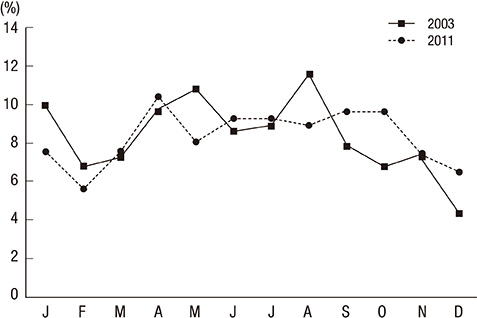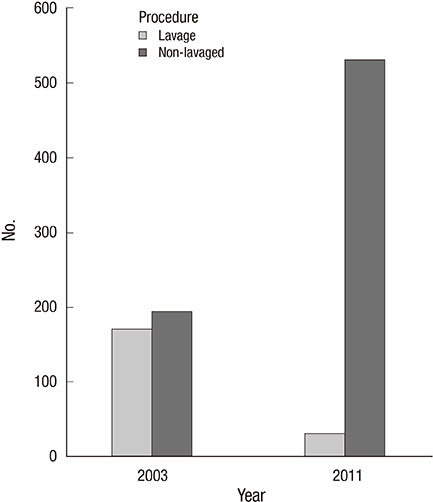J Korean Med Sci.
2013 Oct;28(10):1424-1430. 10.3346/jkms.2013.28.10.1424.
Comparative Analysis of Acute Toxic Poisoning in 2003 and 2011: Analysis of 3 Academic Hospitals
- Affiliations
-
- 1Department of Emergency Medicine, Korea University Medical Center, Seoul, Korea. yellowwizard@hanmail.net
- KMID: 1777676
- DOI: http://doi.org/10.3346/jkms.2013.28.10.1424
Abstract
- Social factors may affect the available sources of toxic substances and causes of poisoning; and these factors may change over time. Additionally, understanding the characteristics of patients with acute toxic poisoning is important for treating such patients. Therefore, this study investigated the characteristics of patients with toxic poisoning. Patients visiting one of 3 hospitals in 2003 and 2011 were included in this study. Data on all patients who were admitted to the emergency departments with acute toxic poisoning were retrospectively obtained from medical records. Total 939 patients were analyzed. The average age of patients was 40.0 +/- 20 yr, and 335 (36.9%) patients were men. Among the elements that did not change over time were the facts that suicide was the most common cause, that alcohol consumption was involved in roughly 1 of 4 cases, and that there were more women than men. Furthermore, acetaminophen and doxylamine remained the most common poisoning agents. In conclusion, the average patient age and psychotic drug poisoning has increased over time, and the use of lavage treatment has decreased.
Keyword
MeSH Terms
-
Acetaminophen/poisoning
Adolescent
Adult
Aged
Aged, 80 and over
Alcohol Drinking
Child
Child, Preschool
Doxylamine/poisoning
Emergency Service, Hospital/*statistics & numerical data
Female
Hospitals, University
Humans
Infant
Infant, Newborn
Male
Middle Aged
Poisoning/*epidemiology
Retrospective Studies
Sex Factors
Suicide, Attempted
Young Adult
Acetaminophen
Doxylamine
Figure
Cited by 1 articles
-
Analysis of Patients with Acute Toxic Exposure between 2009 and 2013: Data from the Korea Health Insurance Review and Assessment Service and the National Emergency Department Information System
Young-Hoon Yoon, Jung-Youn Kim, Sung-Hyuk Choi
J Korean Med Sci. 2018;33(39):. doi: 10.3346/jkms.2018.33.e254.
Reference
-
1. Song KJ, Cho KH, Lee HS. Drug intoxication patients in the emergency department. J Korean Soc Emerg Med. 1992; 3:38–45.2. Han ST, Lee JH. Comparative analysis of acute drug intoxication between 1980s and 1990s. J Korean Soc Emerg Med. 1999; 10:441–446.3. Park JK, Jeong SP, Kim SH, Yoo IS, Park JS, Yoo JH, Jeong SK. The toxic exposure patients of Daejon province by modifiied TESS style. J Korean Soc Clin Toxicol. 2004; 2:1–6.4. So BH, Lee MJ, Kim H, Moon JM, Park KH, Sung AJ, Yeom SR, Oh SB, You JY, Lee KW, et al. 2008 database of Korean toxic exposures: a preliminary study. J Korean Soc Clin Toxicol. 2010; 8:51–60.5. Andrew E, Tellerup M, Termälä AM, Jacobsen P, Gudjonsdottir GA. Poisonings in the Nordic countries in 2007: a 5-year epidemiological follow-up. Clin Toxicol (Phila). 2012; 50:210–214.6. Litovitz T. The TESS database: use in product safety assessment. Drug Saf. 1998; 18:9–19.7. Lee SW, Jeon JM, Hong YS. Analysis of self-poisoning patients. J Korean Soc Emerg Med. 1996; 7:390–397.8. Kang JH, Lee HN, Jin YH, Lee JB. A clinical analysis of acute drug intoxication in emergency department setting. J Korean Soc Emerg Med. 1999; 10:431–440.9. Burillo-Putze G, Munne P, Dueñas A, Pinillos MA, Naveiro JM, Cobo J, Alonso J. Clinical Toxicology Working Group, Spanish Society of Emergency Medicine (SEMESTOX). National multicentre study of acute intoxication in emergency departments of Spain. Eur J Emerg Med. 2003; 10:101–104.10. Xiang Y, Zhao W, Xiang H, Smith GA. ED visits for drug-related poisoning in the United States, 2007. Am J Emerg Med. 2012; 30:293–301.11. Benson BE, Hoppu K, Troutman WG, Bedry R, Erdman A, Höjer J, Mégarbane B, Thanacoody R, Caravati EM. American Academy of Clinical Toxicology. European Association of Poisons Centres and Clinical Toxicologists. Position paper update: gastric lavage for gastrointestinal decontamination. Clin Toxicol (Phila). 2013; 51:140–146.12. Ok TG, Cho JH, Park CW, Cheon SW, Lee SY, Kim SE, Choi KH, Bae JH, Seo JY, Ahn HC, et al. The clinical investigation of gastric lavage in patiernts with acute poisoning. J Korean Soc Clin Toxicol. 2005; 3:22–26.13. Westergaard B, Hoegberg LC, Groenlykke TB. Adherence to international recommendations for gastric lavage in medical drug poisonings in Denmark 2007-2010. Clin Toxicol (Phila). 2012; 50:129–135.14. Lee CA, Choi SC, Jung KY, Cho SH, Lim KY, Pai KS, Cho JP. Characteristics of patients who visit the emergency department with self-inflicted injury. J Korean Med Sci. 2012; 27:307–312.15. Shin SD, Suh GJ, Rhee JE, Sung J, Kim J. Epidemiologic characteristics of death by poisoning in 1991-2001 in Korea. J Korean Med Sci. 2004; 19:186–194.
- Full Text Links
- Actions
-
Cited
- CITED
-
- Close
- Share
- Similar articles
-
- Type and treatment of toxic mushroom poisoning in Korea
- Causative Substance and Time of Mortality Presented to Emergency Department Following Acute Poisoning:2014-2018 National Emergency Department Information System (NEDIS)
- Factor Analysis of Intoxicated Patients Disposition in Pediatric Emergency Department
- Understanding the status of acute poisoning patients who visited the emergency room in 2018: using sample in-depth survey data
- Retrospective Analysis on the Clinical Differences of Children and Adolescents Treated for Acute Pediatric Poisoning in an Emergency Department?





